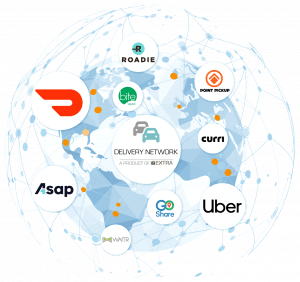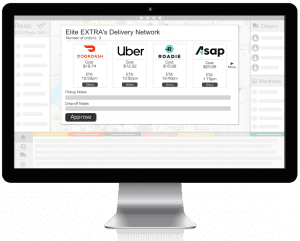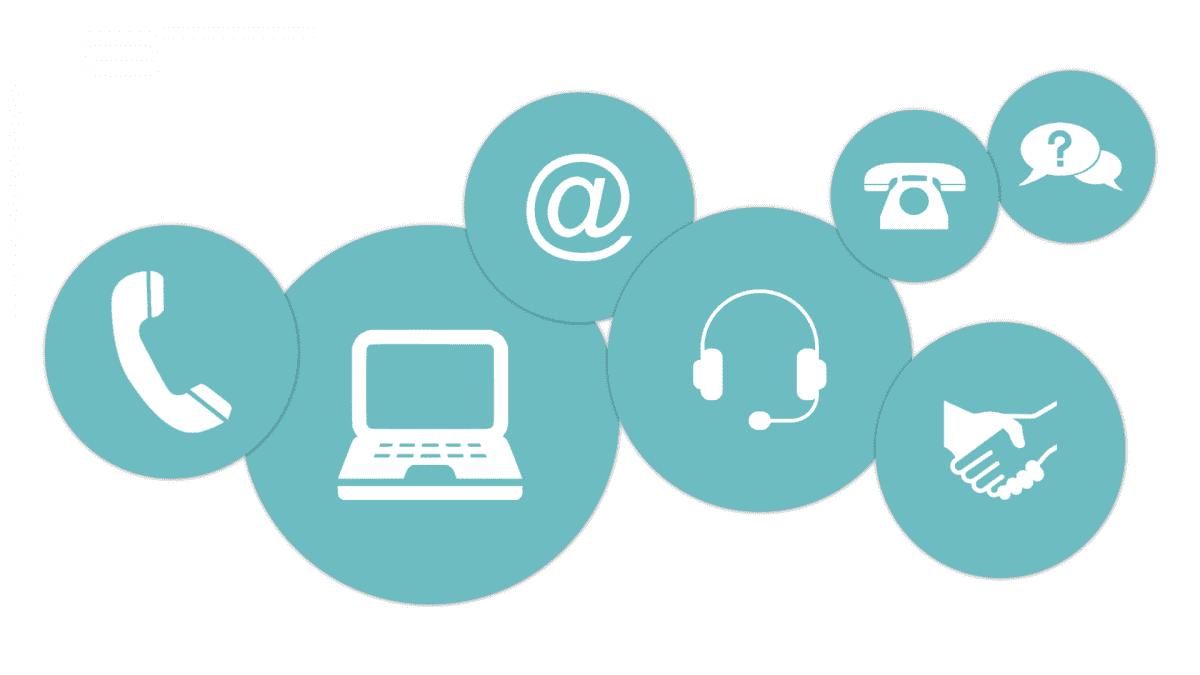
If you’ve ever heard the term ‘delivery hub’ but weren’t sure what it meant, you’re not alone. That’s because it has two distinct meanings depending on the context; it could mean a physical location or an integrated delivery system.
In the physical sense, a delivery hub is where goods are received, sorted, and distributed. It could be a warehouse, fulfillment center, retail store, shipping dock, or any other facility that handles deliveries from one point to the next. This type of delivery hub is often referred to as a “hub and spoke” system because it allows for goods to be transported quickly and efficiently in multiple directions.
In the virtual sense, a delivery hub is an integrated system allowing multiple vendors (third-party delivery providers) to offer their services through a single platform. These systems often include features like tracking, inventory management, payment processing, and more. This flexible, integrated delivery network is often used by eCommerce businesses or those who want to provide their customers with multiple delivery options from different suppliers.
But that’s just the tip of the iceberg; this comprehensive resource dives deeper into the dual meaning of a delivery hub. We’ll cover the following:
- What is a delivery hub?
- Why is it used?
- What does “arrived at the hub” mean?
- What is the alternate meaning of delivery hub (delivery network)?
- Why is a delivery network synonymously referred to as a delivery hub?
- How does a delivery network work?
- Why are delivery networks rising in popularity?
What is a Delivery Hub?
As we hinted above, a delivery hub is a physical location where goods are shipped, stored, and distributed. This could be a warehouse, fulfillment center, or retail store. These hubs help to streamline the process of getting packages from point A to point B by providing secure storage and efficient transportation services. In some cases, they may also offer additional services such as sorting, packing, and repacking goods.
But you may be wondering; why is a delivery hub also referred to as a “hub and spoke” system? A “hub and spoke” system is a transportation network used to move goods from one location to another. It involves using a central hub (or hubs) through which all traffic passes, allowing goods to be quickly and efficiently transported in multiple directions.
The “spokes” are the connections between the hub and other locations where goods can be picked up or delivered. This system is often used by logistics companies, shipping companies, and freight forwarders to move goods from one place to another quickly and cheaply.

Why is It Used?
A delivery hub is used to streamline the transport of goods from one point to another. This system saves companies money by avoiding additional infrastructure or personnel needed to move goods efficiently. Companies can also avoid overhead costs by eliminating the need for multiple warehouses or other storage facilities.
But wait, that’s not all; here are a few more reasons online retailers and logistics providers prefer to use a delivery hub:
- Increased delivery speeds: Having a single hub to receive and sort goods can help speed up deliveries.
- Lower shipping costs: By cutting out additional personnel and overhead expenses, delivery hubs can help keep shipping costs down. Moreover, it reduces delays caused by waiting for goods to be shipped from multiple warehouses.
- Greater control over inventory: Having a single hub for all deliveries allows companies to monitor and manage their inventories better.
- Greater visibility: Delivery hubs provide increased visibility into the flow of goods from one point to another.
- Streamlined tracking process: By having a single location to track all goods, companies can quickly identify where their packages are in the supply chain and ensure that they are delivered on time. This helps to eliminate costly delays and ensures customers receive their orders as soon as possible.
- Unparalleled efficiency: A delivery hub can help improve the efficiency of any supply chain by reducing delays and increasing speed.
What Does “Arrived at the Hub” Mean?
When you receive a notification that your package has “arrived at the hub,” it simply means that it is now being stored at the delivery hub and ready for further processing/sorting and distribution. For example, if it’s a USPS package, it means the item has been sent to the recipient’s USPS office for the final delivery. In other words, the package has arrived at a central location and will be picked up by another truck bound for the recipient’s location.
But how does an online order “arrive at the hub?” Here’s a quick breakdown:
- Passing through numerous intermediary hubs. Before packages reach the central location for sorting, they sometimes travel through various intermediary hubs per the order processing protocols. This helps to ensure that all packages are properly identified, sorted, and tracked.
- Processing and sorting. While in the intermediary hubs, packages get prepared, sealed, addressed, and stamped per the recipient’s address. This helps to speed up delivery times and ensure that a package reaches its destination quickly and safely.
- Transportation to a distribution center. Now that the package has been processed and sorted, it’s time to place them in a bigger truck for transport to a distribution hub. For instance, if it’s a USPS package, the truck will take it to the nearest decentralized hub, usually within a four-hour drive from most U.S. cities. The package will then be sorted and delivered to the final destination.
What is the Alternate Meaning of Delivery Hub (Delivery Network)?

Recently, a delivery hub has been used synonymously with a delivery network. But unlike the typical hub, a delivery network is more of a network of third-party delivery providers that are available to deliver on demand for companies.
A delivery network is a simplified way of partnering with these transportation services so that companies can easily meet customer delivery demands. A delivery network typically includes several transportation providers, especially last-mile delivery companies like DoorDash, Roadi, and Curri.
These providers rely on an integrated, feature-packed system to ensure that goods are delivered on time and in the most cost-effective manner possible. Some delivery networks also offer additional services such as routing & dispatch, tracking, notifications, and returns management – more on this later.
Why is a Delivery Network Synonymously Referred to as a Delivery Hub?
A delivery network is often referred to as a delivery hub because, at its core, it seeks to provide the same streamlined and efficient tracking process that a typical hub does. In both cases, companies have access to real-time data and insights on their packages’ progress, allowing them to quickly identify where their goods are in the supply chain and ensure they are delivered on time.
Delivery networks also allow companies to effortlessly scale up or down their delivery operations depending on demand. This is especially useful for businesses that experience seasonal fluctuations in demand or need rapid expansion. With a delivery network, companies can easily add new carriers and subcontractors to their logistics chain, helping them quickly meet customer demand and increase efficiency.
Additionally, many delivery networks offer integrated services that allow companies to streamline the entire delivery process from order taking, tracking, and delivery. This is especially helpful for businesses that do not have an in-house logistics team, as it allows them to easily access a wide range of transportation providers without having to make separate contracts with each one.
How Does a Delivery Network Work?
A delivery network typically connects businesses with various last-mile delivery partners, such as carriers and subcontractors. These partners can be added to the network anytime, allowing companies to scale up or down their operations depending on demand. When an order is placed, the delivery network leverages its powerful engine to identify the best partner for that particular job. This helps ensure that orders are fulfilled faster and cost-efficiently.
Here’s a more straightforward 4-step breakdown of how a delivery network works:
Step 1: Integration into Your eCommerce Platform

Integrating a delivery network into your eCommerce platform is the first step. Delivery networks provide an easy way for businesses to connect with various last-mile transportation providers. Once connected, companies can seamlessly send customer orders to third-party fleets for delivery.
Step 2: Identifying an Appropriate Delivery Model
Here, customers can choose between same-day delivery at checkout or other priority delivery options. This helps them get the package sooner without sacrificing quality.
Step 3: Identifying a Suitable Delivery Partner
After the customer chooses their preferred delivery option, the system automatically identifies the best third-party fleet to pick up and deliver the order. The selection criteria may be based on customer preference, geographic proximity, delivery experience, or other factors.
Step 4: Automated Tracking and Communication
Once the order is placed, customers can track its progress in real time via eta alerts and tracking pages. This ensures that customers are kept informed about their orders and can take action if something goes awry.
Why are Delivery Networks Rising in Popularity?
More and more last-mile delivery providers and clients prefer to use delivery networks to fulfill orders, hence the skyrocketed popularity. This section explores the top reasons to use a delivery hub with an integrated management system:
- Freedom to select and work with your preferred providers. The best delivery networks prioritize customer satisfaction above all else. Hence, it provides clients multiple delivery options and the ability to choose a provider that meets their specific order requirements.
- Optimized delivery processes. It doesn’t matter how complex or straightforward your fulfillment needs are; a reliable delivery network accommodates unique business needs and parameters, including budget, quality, availability, and more.
- Centrally managed hub. All the data associated with order fulfillment is collected and stored in the central hub, making tracking valuable information such as delivery status, delivery times, and customer feedback easier. Moreover, the system can be used to generate reports for operational insights.
- Reduced operational costs. A delivery network allows businesses to save money on last-mile delivery costs. It offers a centralized system to manage orders and integrate providers, reducing the need for additional workforce and manual processes.
- Enhanced customer experience. By providing customers multiple delivery options, businesses can ensure faster deliveries, better customer service, and improved overall satisfaction rates. A delivery network also lets customers track their orders in real time, giving them more control over the entire process.
- Improved Flexibility. Delivery networks allow businesses to scale up or down as needed. It eliminates the need for long-term contracts with multiple providers, allowing companies to adjust their fulfillment needs accordingly. Additionally, delivery networks can be easily adapted to meet the changing needs of customers and the market.
- Enhanced Visibility. Delivery networks give businesses visibility into their entire order fulfillment process, ensuring customers receive the best possible experience. The system also helps companies identify improvement areas, allowing them to make necessary changes and improve the customer experience even further.
Elite EXTRA is Your No.1 Rated Delivery Network!
So there you have it! A delivery hub is a platform or system that enables businesses to manage their last-mile delivery processes more efficiently and effectively. It provides various features, including optimized delivery processes, centrally managed hubs, reduced operational costs, enhanced customer experience, improved flexibility, and enhanced visibility.
With a delivery hub, businesses can ensure better order fulfillment processes, lower operational costs, and improved customer satisfaction rates. Besides, a dynamic delivery system like Elite EXTRA allows businesses to quickly adapt to changing customer demands, so they can better meet the ever-changing needs of their customers.
Since 2008, Elite EXTRA has been streamlining logistics operations for 325,000+ clients worldwide. Our solution improves customer experience through optimized delivery processes, reduced operational costs, enhanced visibility, and flexibility. We also have a highly responsive customer service team to help you with queries or issues 24/7.
So if you’re in the market for a reliable and cost-effective delivery network, look no further than Elite EXTRA. Request a demo today to see how we can help your business reach the next level!
Sources
https://www.asianausa.com/warehouse-vs-fulfillment-centers-whats-difference/
https://blog.locus.sh/hub-and-spoke-distribution-model-in-modern-supply-chains/
https://www.linkedin.com/pulse/why-should-you-prioritize-customer-satisfaction-your-business/







